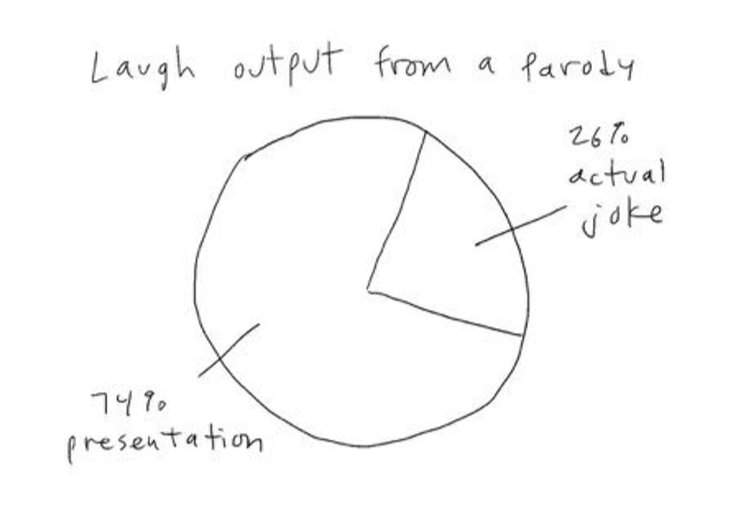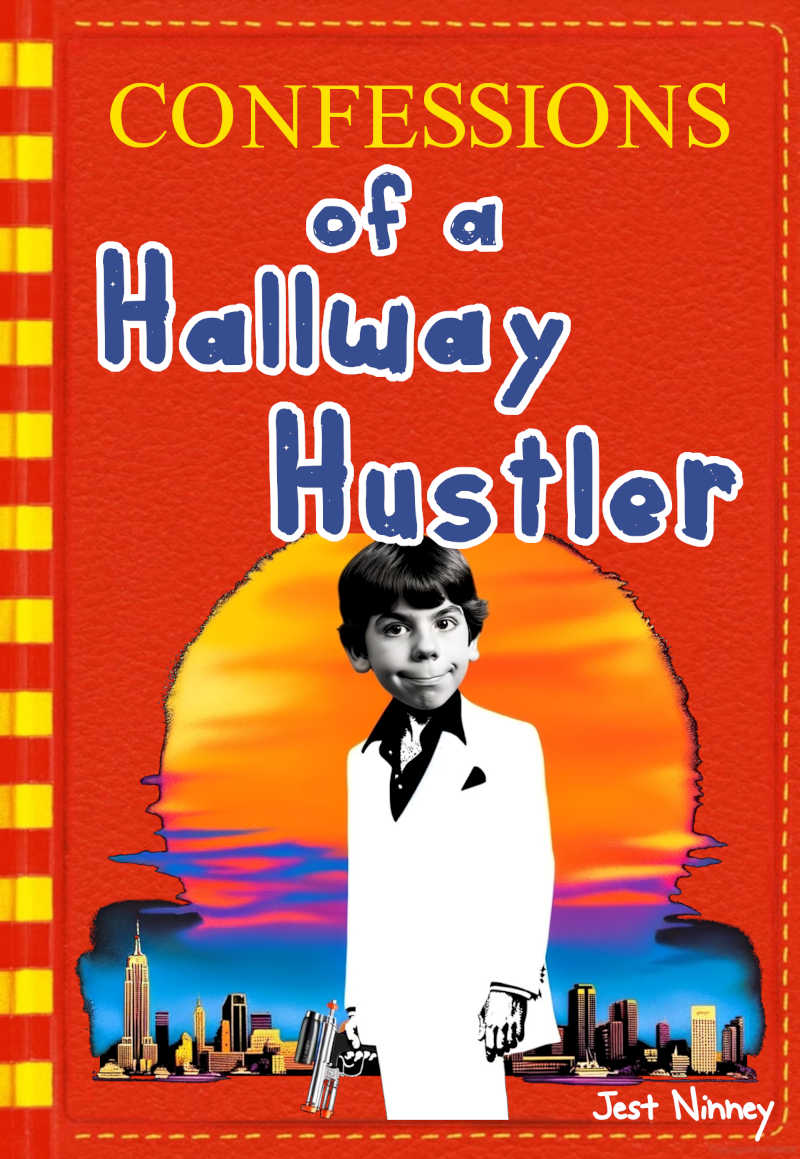The following is an excerpt from How To Write Funny: Your Serious, Step-By-Step Blueprint For Creating Incredibly, Irresistibly, Successfully Hilarious Writing by Scott Dikkers (full citation below).
Parody
Parody is making fun of another entertainment or information product. Any piece of writing, type of presentation, or anything intended to be presented to the public in any medium can be the target of Parody. That includes anything from a specific TV show, movie, book, magazine, or anything—all the way down to a church pamphlet, bus schedule or street sign. Beyond specific presentations or creators, overall media like movies, the stage or visual art can also be parodied.

Parody works best if readers are familiar with the work or medium being parodied. Not too many people may understand your brilliant parody of Inuit song duels. But if it’s a more commonly experienced format or medium, or a popular (or at least reasonably well-known) specific entertainment product, you can parody it and be assured people will get it. The Onion parodies a news website and the AP style used in most newswriting, and they do so in just about every article they publish. The Diary of a Wimpy Kid web comic and books parody, of course, a diary. Ian Frazier won the Thurber Prize for American Humor largely because of his brilliant piece, “Coyote v. Acme,” which parodies both the Road Runner cartoons and a modern legal brief.
You parody something by mimicking its format, voice, or anything about it that calls it clearly to mind for your reader.
Parody is a powerful tool in humor. Readers will often laugh before they’ve even read any of your words—they’ll merely see the context of your Parody (a design, presentation, or other framing device) that calls to mind the specific thing you’re parodying, and that alone will amuse them greatly. You can see this phenomenon in action on SNL whenever they parody a popular movie. As soon as the lights come up on the set and the audience recognizes the movie’s likeness, they laugh. They laugh even harder when a cast member appears, looking very much like a key character in the movie. Before a single word of dialog is spoken, the audience is already laughing. This is how effective Parody can be.
With Parody, you accomplish two things. First, as with the other Funny Filters, you elucidate whatever Subtext you want. Second, you provide a kind of second Subtext, which is your opinion of whatever it is you’re parodying. For maximum comic effect with Parody, the medium becomes the message.
In the examples above, Parody is used both to convey Subtext and lampoon the medium. Most stories in The Onion have their own Subtext, like, for example, a story about the government might have the time-honored Subtext, “our government is incompetent.” But on top of that, The Onion is also, through its Parody format, saying, “modern journalism is worthless.” This second layer of hidden meaning has very little to do with the core Subtext of the article. It casts a larger net, asking readers to question everything they read in the news.
In “Coyote v. Acme,” Frazier casts a ridiculously logical light on Looney Tunes. On top of that, he indicts our litigious society with his parody of the legal brief. His piece is brimming with Subtext: commenting on the ridiculous nature of cartoons, the pervasiveness of liability claims, as well as weak consumer protections.
There’s one simple rule to using Parody. The writing or the design, format or framing device of the writing, must mirror the thing being parodied as closely as possible. This is what readers love about Parody; they like to see how close you can get it. If you’re parodying another writer’s style you must get it right, down to every syllable and punctuation mark. If you don’t, if your Parody is half-baked, it won’t be as funny.
Obviously, you don’t want to mimic the content. That’s the new element you’re bringing to the table. You want to mimic only the form, format and/or presentation of your target. That might be the way it looks, the way it sounds, other quirks about it, or all the above.
Note how The Onion perfectly apes AP style in its newswriting. Note how Frazier gets every little phrase of his legal brief just right, so it sounds exactly like a real legal brief. Jeff Kinney uses the tone, syntax and even a hand-written font that makes his books look exactly like a kid’s diary.
Readers love verisimilitude—when Parody comes eerily close to reality. The closer the resemblance, the better.
I credit National Lampoon for significantly raising the bar on Parody. They put more thought into it, used professional designers and had a seemingly more serious approach than their predecessors, like Mad, to more precisely mimic the object of their parodies. Their 1964 High School Yearbook is a great example.
A lot of humor writers think they can succeed with Parody by going half-way and getting the mimicry close enough. This may work, and will result in some people finding it amusing. But in order to generate big laughs with the widest possible audience, go all the way with Parody. Play it straight and don’t wink at the reader. This elevates your work to a kind of hoax, where those not in the know may actually be fooled into thinking what you’ve created is the real thing, which happens all the time to The Onion. There’s scarcely anything funnier or more satisfying to the writer—and those select few in the audience who are in on the joke—than seeing other people fooled by a work of Parody.
How do you write Parody in a single line or joke? Think of other writing that’s a similar size: a fortune cookie, a horoscope, a weather forecast, a newspaper headline or a tweet. There are so many. By borrowing a format like these and mimicking it so closely that everyone who reads it knows what you’re referring to, you can harness the immense satirical power of the Parody Funny Filter.
Some parody one-liner examples (from me):
The least scary man-turning-into-insect movie: The Human Lady Bug
They should make an app that has car-trip games like License Plate ABCs, but instead of looking out the window you look at your phone.
Book: The Complete Idiot’s Guide to Being a Complete Idiot
Parody summary
What it is:
Aping another entertainment or information product, format or specific presentation
How to use it:
Use verisimilitude. Make your Parody look or sound as much like the real thing as possible.
Who is Scott Dikkers?
Scott Dikkers is an American comedian, writer, and entrepreneur best known as one of the founding editors of “The Onion,” a satirical news publication. Born on March 1, 1965, in Minneapolis, Minnesota, Dikkers started his career in comedy writing and eventually co-founded “The Onion” in 1988 while attending the University of Wisconsin-Madison. Under his leadership, the publication gained national acclaim for its sharp wit and social commentary, eventually expanding into various media formats including books and television.
Dikkers has received multiple awards for his work, including a Peabody Award in 2008. In addition to his role at “The Onion,” he has authored several books and served as a faculty member at The Second City, a renowned improvisational comedy enterprise.
His contributions to comedy and satire have made him a significant figure in modern American humor.
Further study
Dikkers, Scott. How to Write Funny: Your Serious, Step-By-Step Blueprint For Creating Incredibly, Irresistibly, Successfully Hilarious Writing (pp. 98-102). SD Books. Kindle Edition.

